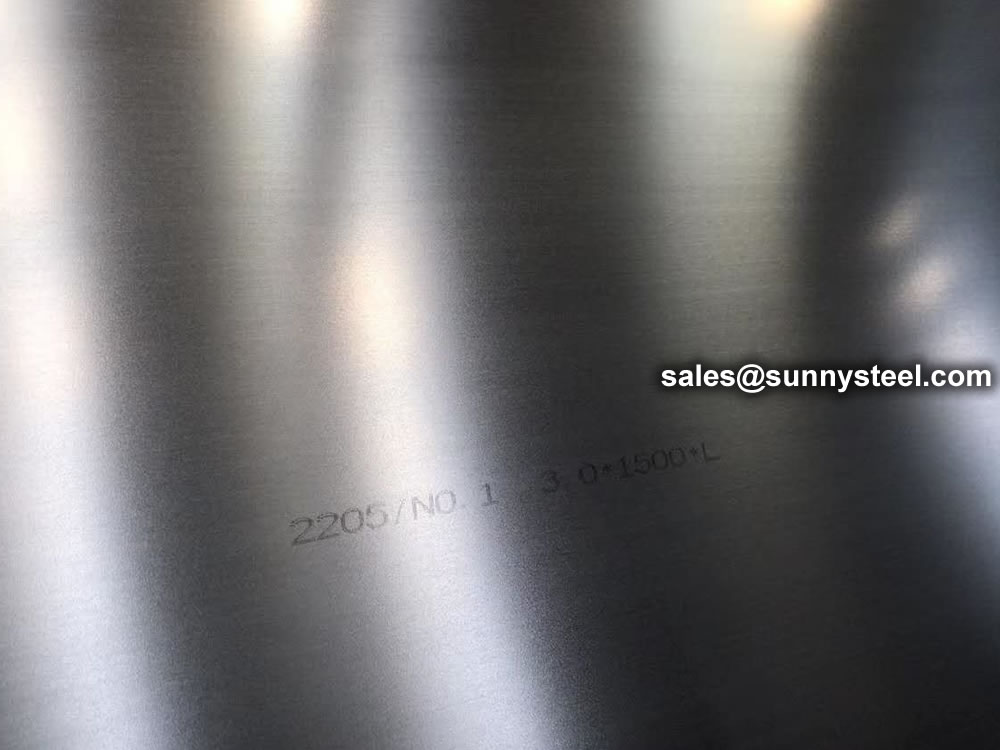
UNS S32205 Duplex Stainless Steel Plate is a chromium-nickel- molybdenum-nitrogen stainless steel.
Duplex stainless is a mixed microstructure of austenite and ferrite (50/50) which has improved strength over ferritic and austenitic steel grades with similar corrosion resistance qualities.
One of the main attractions of duplex stainless steel is cost – due to the materials increased yield strength it is often possible to reduce the thickness of material making it much cheaper than a comparative austenitic stainless steel grade.
Also Duplex steel has a lower alloy content reduces production costs. Certainly cost and weight savings without loss of performance is an attractive proposition to Purchasers.
Forming below 600°F is recommended whenever possible. When hot forming is required, the workpiece should be heated uniformly and worked in the range of 1750 to 2250°F. Alloy 2205 duplex stainless steel plate is quite soft at these temperatures and is readily formed. Above this range, 2205 is subject to hot tearing. Immediately below this range, the austenite becomes substantially stronger than the ferrite and may cause cracking, a particular danger to “cold” edges. Below 1700°F there can be rapid formation of intermetallic phases because of the combination of temperature and deformation. Whenever hot forming is done, it should be followed by a full solution anneal at 1900°F minimum and rapid quench to restore phase balance, toughness, and corrosion resistance. Stress relieving is not required or recommended; however, if it must be performed, the material should receive a full solution anneal at 1900°F minimum, followed by rapid cooling or water quenching.
Alloy 2205 duplex stainless steel plate is readily sheared and cold formed on equipment suited to working stainless steels. However, because of the high strength and rapid work hardening of 2205 duplex stainless steel plate, forces substantially higher than those for austenitic steels are required to cold form it. Also because of the high strength, a somewhat larger allowance must be made for springback.
Alloy 2205 duplex stainless steel plate should be annealed at 1900°F minimum, followed by rapid cooling, ideally by water quenching. This treatment applies to both solution annealing and stress relieving. Stress relief treatments at any lower temperature carry the risk of precipitation of detrimental intermetallic or nonmetallic phases.
With high-speed steel tooling, 2205 duplex stainless steel plate may be machined at the same feeds and speeds as Alloy 316L. When carbide tooling is used, cutting speeds should be reduced by about 20% relative to the speeds for Alloy 316L. Powerful machines and rigid mounting of tools and parts are essential.
Alloy 2205 duplex stainless steel plate possesses good weldability. The goal of welding 2205 is that the weld metal and heat-affected zone (HAZ) retain the corrosion resistance, strength, and toughness of the base metal. The welding of 2205 is not difficult, but it is necessary to design welding procedures that lead to a favorable phase balance after welding and will avoid precipitation of detrimental intermetallic or nonmetallic phases.
Alloy 2205 duplex stainless steel plate can be welded by: GTAW (TIG); GMAW (MIG); SMAW (“stick” electrode); SAW; FCW; and PAW.
| C | Cr | Fe | Mn | Mo | N | Ni | P | S | Si |
|---|---|---|---|---|---|---|---|---|---|
| Max | Max | Max | Max | Max | |||||
| .03% | 22%-23% | BAL | 2.0% | 3.0% -3.5% | .14% - .2% | 4.5%-6.5% | .03% | .02% | 1% |
Some of the typical applications of duplex steel grade 2205 are listed below:
The physical properties of grade 2205 stainless steels are tabulated below.
| Grade | Density (kg/m3) |
Elastic Modulus |
Mean Co-eff of Thermal Expansion (μm/m/°C) |
Thermal Conductivity (W/m.K) |
Specific Heat 0-100°C ( J/kg.K) |
Electrical Resistivity (nΩ.m) |
|||
|---|---|---|---|---|---|---|---|---|---|
| 0-100°C | 0-315°C | 0-538°C | at 100°C | at 500°C | |||||
| 2205 | 782 | 190 | 13.7 | 14.2 | - | 19 | - | 418 | 850 |
Corrosion Resistance
Grade 2205 stainless steel exhibits excellent corrosion resistance, much higher than that of grade 316. It resists localized corrosion types like intergranular, crevice and pitting. The CPT of this type of stainless steel is around 35°C. This grade is resistant to chloride stress corrosion cracking (SCC) at temperatures of 150°C. Grade 2205 stainless steels are apt replacements to austenitic grades, especially in premature failure environments and marine environments.
The super duplex gradesare even more resistant to corrosion.
Heat Resistance
Fabrication
Fabrication of all stainless steelsshould be done only with tools dedicated to stainless steel materials. Tooling and work surfaces must be thoroughly cleaned before use. These precautions are necessary to avoid cross contamination of stainless steel by easily corroded metals that may discolour the surface of the fabricated product.
Welding
Most standard welding methods suit this grade, except welding without filler metals, which results in excess ferrite. AS 1554.6 pre-qualifies welding for 2205 with 2209 rods or electrodes so that the deposited metal has the right balanced duplex structure.
Adding nitrogen to the shielding gas ensures that adequate austenite is added to the structure. The heat input must be maintained at a low level, and the use of pre or post heat must be avoided. The co-efficient of thermal expansion for this grade is low; hence the distortion and stresses are lesser than that in austenite grades.
Machinability
Although machinable, the high strengths of duplex stainless steels makes machining difficult. As an example, machining of 2205 is around 20% slower than for 304.
Machining can be enhanced by using the following rules:
Heat Treatment
Duplex stainless steelscannot be hardened by heat treatment. They can however be work hardened.
Solution treatment or annealing can be done by rapid cooling after heating to around 1100°C.
Weldability
Duplex stainless steelshave good weldability. All standard welding processes can be used. They are not quite as easily welded as the austenitic grades but low thermal expansion in duplex grades reduces distortion and residual stresses after welding. The recommended filler material for 2205 stainless steelis 2209.

When you partner with Sunny Steel, you can stop worrying about meeting deadlines thanks to our responsive and timely service. You'll also say goodbye to unnecessary shopping around. Instead, you'll get white glove service from an expert who understands your needs and can get you the materials you need quickly.
